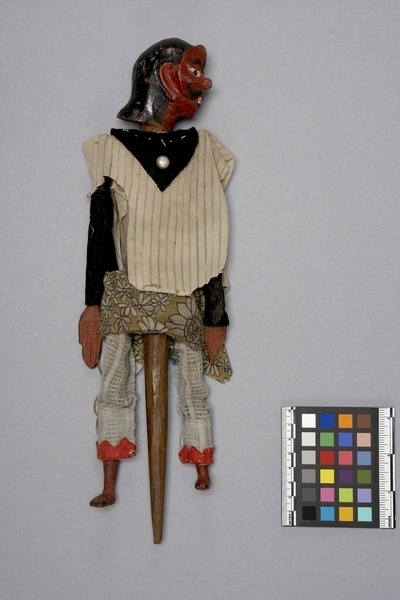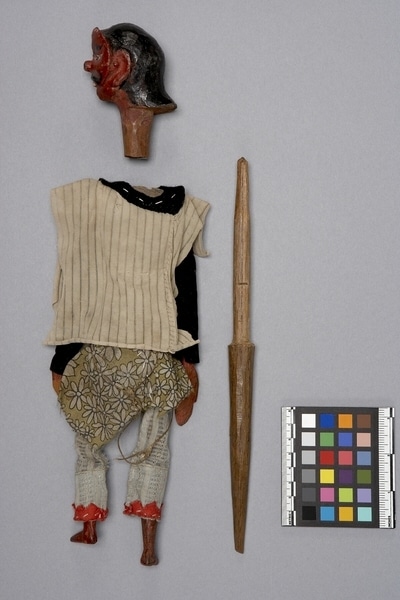Rod Puppet Item Number: Ib307 from the MOA: University of British Columbia


Description
Three-dimensional wooden male humanoid puppet. Wooden body (part a); arms and jointed legs attached with small nails. Left hand damaged. Body covered with light brown over-cape with black collar and silver bead. Arms covered with tied on black material. Green and light brown floral patterned skirt. Legs covered with tied on grey material with red cuffs. Carved head (part b), and pointed rod (part c); red face mask, with black and white detail. Prominent white front tooth. Smooth black shoulder length hair. Rod is pointed to a tapered end.
History Of Use
Javanese puppetry as an art form probably developed by the 11th century. The three-dimensional wooden wayang golek puppets of western Java, which are to be distinguished from the earlier and more sacred wayang kulit shadow plays puppets or other forms, appeared during the 16th century. Originally the plays depicted Javanese mythology, but after the Indian conquest of Java the Hindu epics, Ramayana and Mahabharata, were incorporated into the cycles, which comprise about 200 plays. An individual or group hires a dalang (puppet-master) to celebrate important occasions. The performances often last all night and are generally presented in three acts, with vocal and instrumental accompaniment. The individual plays vary widely in detail but usually involve conflict between good and evil. They serve a moral and religious purpose, and more recently, one of political commentary. Each puppet's character is represented by its appearance and placement onstage; protagonists with strong elements of good are placed to the right, antagonists of violent or evil nature to the left. Character of puppet unknown; not determined what role it plays or in which plays. Mask unusual.
Cultural Context
Theatrical performance.
Iconographic Meaning
Character has few discernible qualities; face covered by mask, clothing unusual and may be a deliberate disguise. Red face usually associated with evil or violent character; large extended tooth found on the Punakawan, clowns of the wayang.
Item History
- Made in Java, Indonesia
- Owned by Tradewind Antiques before March 15, 1983
- Received from Museum of Anthropology Shop Volunteers (Funding source) and Tradewind Antiques (Seller) on March 15, 1983
What
- Name
- Rod Puppet
- Identification Number
- Ib307
- Type of Item
- puppet
- Material
- wood, cotton fibre, paint and synthetic fibre
- Manufacturing Technique
- carved, painted, machine woven, machine stitched and hand sewn
- Part A
- height 26.5 cm, width 12.0 cm, depth 4.1 cm
- Part B
- height 10.0 cm, width 4.8 cm, depth 6.6 cm
- Part C
- height 28.0 cm, diameter 1.9 cm
Who
- Culture
- Sundanese
- Previous Owner
- Tradewind Antiques
- Received from
- Museum of Anthropology Shop Volunteers (Funding source) and Tradewind Antiques (Seller)
Where
- Holding Institution
- MOA: University of British Columbia
- Made in
- Java, Indonesia
When
- Ownership Date
- before March 15, 1983
- Acquisition Date
- on March 15, 1983
Other
- Condition
- good
- Accession Number
- 0886/0041